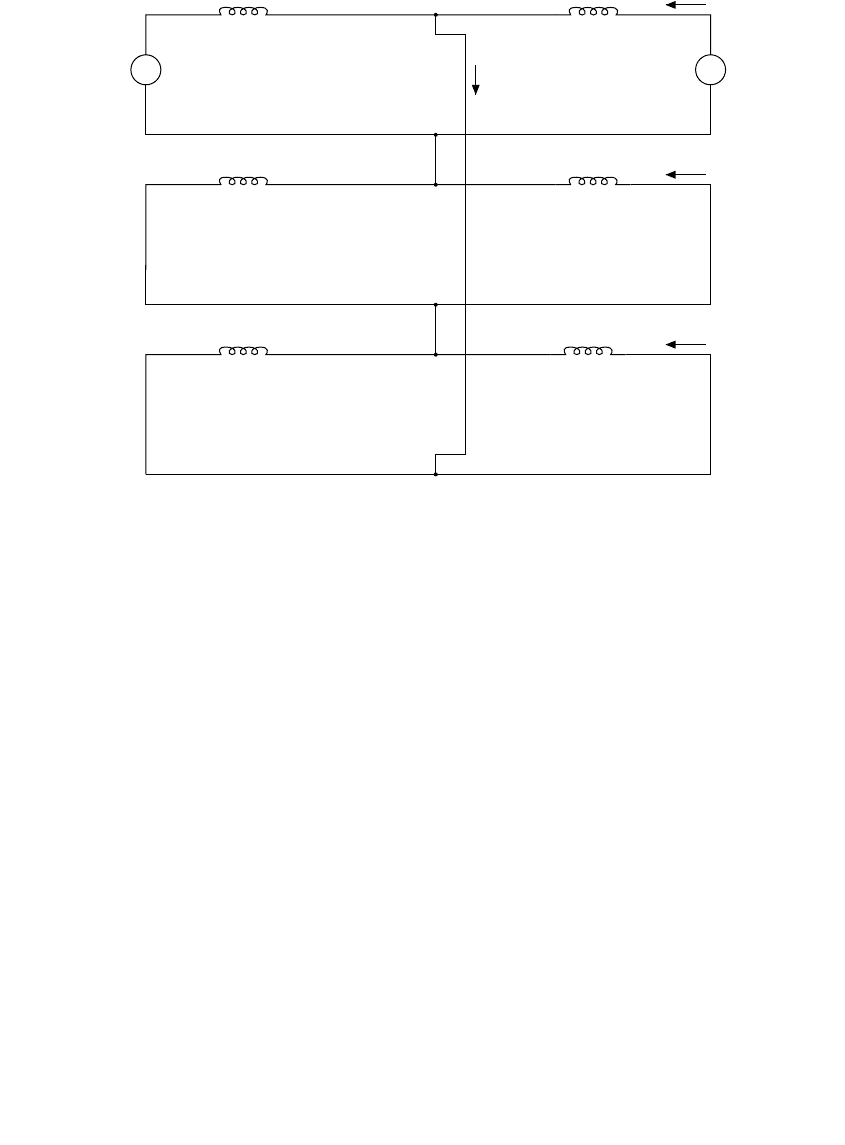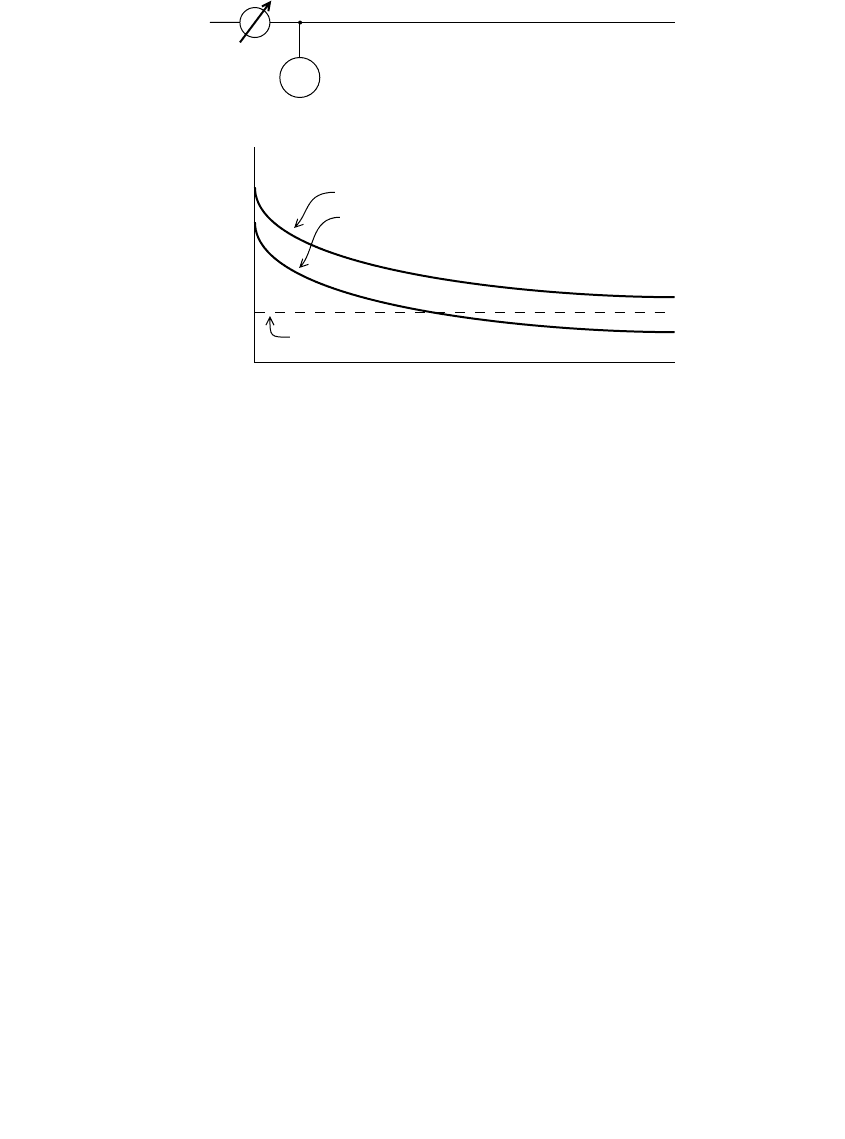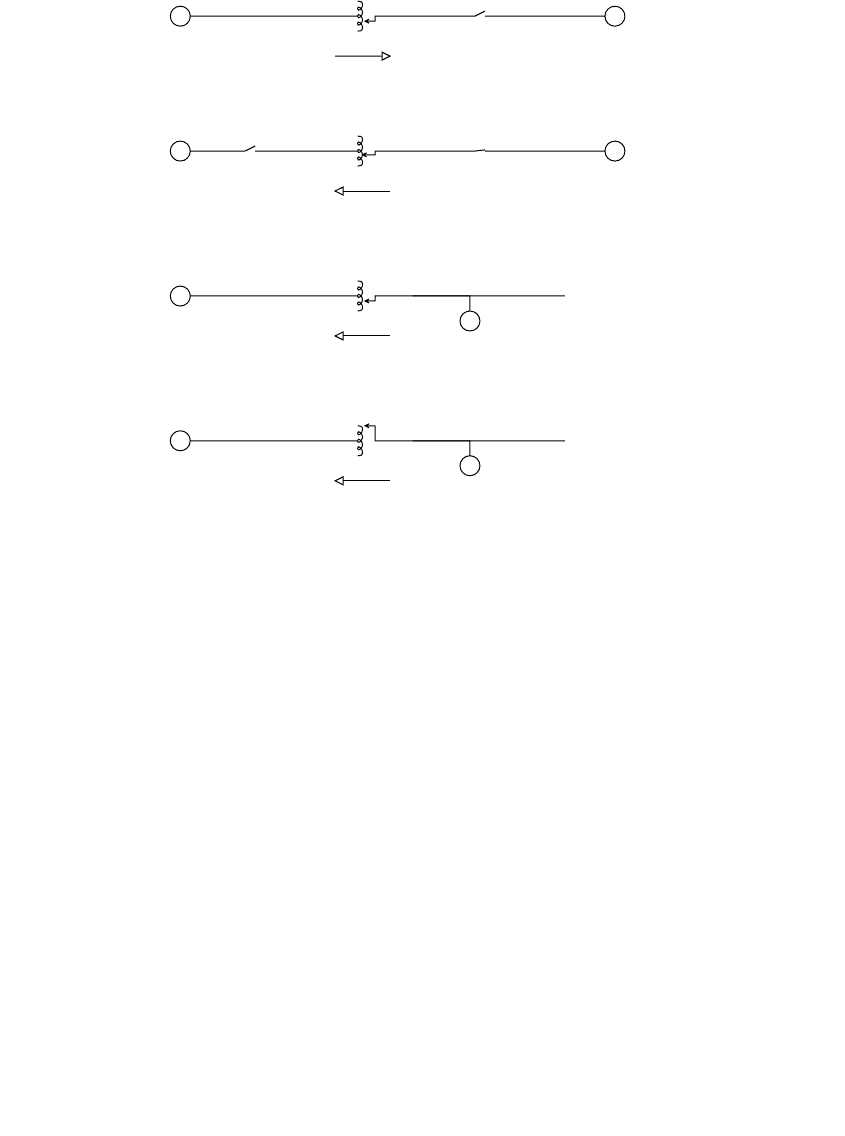Short T.A. Electric Power Distribution Handbook
Подождите немного. Документ загружается.


Distributed Generation 729
transformer impedance, and the transmission equivalent
impedance
Z
0
, Z
1
, Z
2
= zero, positive, and negative-sequence impedance between
the generator and fault. This includes the equivalent genera-
tor impedance reflected to the primary-side voltage, the
transformer impedance, and the line impedance from the
generator to the upstream device
The phase relay on the faulted phase sees the following current:
I
faulted phase
= I
G1
+ I
G2
+ I
G0
The ground relay operates on
I
ground relay
= 3I
G0
While the line-to-ground fault current is normally smaller than the three-
phase fault current, it is important because of
FIGURE 14.12
Sequence diagram of a line-to-ground fault with a downstream generator feed. (Copyright ©
2000. Electric Power Research Institute. 1000419. Engineering Guide for Integration of Distributed
Generation and Storage Into Power Distribution Systems. Reprinted with permission.)
Substation DGFault
Z
0
Z
1
Z
2
Z
S0
Z
S1
Z
S2
I
G0
I
G1
I
G2
I
0
VV
1791_book.fm Page 729 Monday, August 4, 2003 3:20 PM
(C) 2004 by CRC Press LLC

730 Electric Power Distribution Handbook
• Relay sensitivity — The upstream protective device (breaker, recloser,
or sectionalizer) may have a ground relay that is more sensitive than
the phase relay setting. Even if the ground-fault current is lower,
increased ground-relay sensitivity may cause miscoordination.
• Grounding sources — Two common generator transformer configu-
rations supply significantly more ground fault current; their zero-
sequence impedance is low (see Figure 14.13):
•Grounded-wye – delta transformer connection — This grounding
transformer presents a zero-sequence impedance equal to the
transformer impedance (about 5% of its rating).
•Grounded-wye – grounded-wye transformer connection with a
rotating generator solidly grounded — A rotating generator has
low zero-sequence impedance (5% of its rating). The total zero-
sequence impedance is the transformer impedance plus the gen-
FIGURE 14.13
DG grounding source connections feeding single-phase faults.
Substation
Substation
G
G
Fault
Fault
Z
0
Z
T
Z
G0
5% 5% 10%
Z
0
Z
T
5%
1791_book.fm Page 730 Monday, August 4, 2003 3:20 PM
(C) 2004 by CRC Press LLC

Distributed Generation 731
erator impedance (Z
T
+ Z
G0
ª 5% + 5% = 10%, assuming both the
transformer and generator have the same kVA rating).
To determine whether the upstream device will misoperate, compare the
fault current with the pickup setting of the device. If it exceeds the pickup,
then examine the time-current characteristics of the protective device. If it
is an instantaneous element, then assume it miscoordinates. If the device has
a time-delay characteristic, then compare the operating time for the given
fault current to the operating time of the next upstream device.
If false tripping of utility protective devices is found, there are several
possible remedies. On the generator side, the corrective options are
• Size — Limit the size of the generator to the point where coordination
is achieved.
• Impedance — Increase the impedance of the generator transformer
or generator.
• Ground faults — If miscoordination occurs from ground faults, add
a grounding reactor to the generator (for a grounded-wye –
grounded-wye interconnection).
On the utility side, the options are
• Settings — Use a higher pickup setting on the upstream device or use
a slower characteristic that coordinates with the generator contribu-
tion. Of course, this requires checking to make sure that the distri-
bution circuit is still adequately protected and that the new setting
coordinates with other protective devices on the distribution circuit.
• Instantaneous — Disable the instantaneous element or add a time
delay to the instantaneous element of sufficient length to coordinate.
• Fuses — Use a larger and/or slower fuse.
• Ground faults — If it is a ground-protection issue with a grounded-
wye – delta interconnection transformer, add a primary neutral
reactor.
If the generator is a large rotating unit that is close to the nearby protective
device, then there may be a significant offset to the fault waveshape. This
may affect certain protective devices. If the device is close to miscoordinating
given the equations above, then use a more advanced approach with a short-
circuit program that accounts for the offset.
14.3.1 Tradeoff Between Overvoltages and Ground Fault Current
The transformer/generator grounding plays important roles in supplying
ground fault currents and overvoltages that may occur during islanding.
1791_book.fm Page 731 Monday, August 4, 2003 3:20 PM
(C) 2004 by CRC Press LLC

732 Electric Power Distribution Handbook
Better grounding limits the overvoltage, but the generator supplies more
ground fault current, which may affect coordination.
At one extreme are the sources that form grounding transformers that can
provide significant fault current:
• Grounded wye – delta — The zero-sequence impedance of the inter-
connection is the transformer impedance, normally about 5% on its
rating.
• Grounded wye – grounded wye with the generator solidly grounded —
The zero-sequence impedance is about 10% (5% for the transformer
and 5% for the generator).
At the other extreme are ungrounded connections, which provide no
ground fault current but cause an overvoltage of 1.73 per unit on the
unfaulted phases during a ground fault (note that these can feed ground
faults, just not with zero sequence):
• Delta – delta
• Delta – grounded wye
•Grounded wye – grounded wye with the generator ungrounded
Where ground-fault coordination is a problem, in-between approaches are
often best. Adding a grounding reactor to a grounded wye – delta or adding
a grounding reactor to a generator limits the ground-fault current.
It is normally possible to do both — have effective grounding and reason-
ably limit the zero-sequence fault contribution.
Figure 14.14 shows the tradeoffs with overvoltages and grounding for an
example case. The case has a generator with a grounded-wye – delta trans-
former connection on a 12.47-kV circuit, 4 mi (6.4 km) from the substation.
The transformer has a reactor in the grounded-wye primary. The example
assumes a 5% transformer impedance, 20% positive and negative-sequence
reactances for the generator, and a 1.1 per-unit voltage behind the generator
impedance. Reactor size determines the grounding effectiveness. The reactor
impedance is shown as per-unit multiples of the transformer impedance.
Except for very large generators relative to the distribution system capability,
using a reactor can effectively ground the circuit (overvoltages less than 1.25
per unit) and still reasonably limit the zero-sequence current.
Note that a grounded-wye – grounded-wye transformer with the generator
solidly grounded has similar results to the case with a reactor of 0.3 per unit
in Figure 14.14. In this solidly grounded scenario, the generator supplies
significant fault current.
14.3.2 Fuse Saving Coordination
The majority of faults on overhead distribution lines are temporary (meaning
the fault will be cleared if power is interrupted and restored). Temporary
1791_book.fm Page 732 Monday, August 4, 2003 3:20 PM
(C) 2004 by CRC Press LLC

Distributed Generation 733
faults on lateral taps can be cleared by the feeder breaker before the lateral
fuse blows. This is usually done with the instantaneous element of the
breaker relay or recloser in the substation. This practice is known as fault
selective feeder relaying or simply as “fuse saving.” Distributed generators
increase the fault current through the fuse, which may blow the fuse before
the breaker opens.
Locations with lower fault currents are where generators are most likely
to blow fuses. At locations where fault currents are already high, fuses will
not coordinate with a station breaker (so generators will not make the situ-
FIGURE 14.14
Overvoltages and zero-sequence fault contribution for a grounded-wye – delta interconnection
transformer with a neutral reactor for different size generators (the overvoltage remains the
same with size).
5 MVA
2 MVA
0 2 4 6 8 10
0
200
400
600
800
0 2 4 6 8 10
1.0
1.2
1.4
1.6
Zero-sequence current, A
500 kVA
Reactor neutral impedance
in per unit of the interconnection transformer impedance
Overvoltage, per unit
1791_book.fm Page 733 Monday, August 4, 2003 3:20 PM
(C) 2004 by CRC Press LLC

734 Electric Power Distribution Handbook
ation worse). Table 14.5 shows this for the commonly used K links. The
smallest fuses that can coordinate during fuse saving are shown given the
fault current from the substation and a distributed generator. The generator
size in the last column is specifically for a 12.47-kV system with a synchro-
nous generator with X
d
≤ = 0.2; the generator fault current contributions in
the first column of the table can be applied for other applications.
14.4 Power Quality Impacts
14.4.1 Voltage Regulation
Distributed generation often helps voltage on a distribution circuit because
it offsets some of the voltage drop caused by loads. But, distributed gener-
ation can cause voltages outside of ANSI C84.1 limits under the following
scenarios:
• Voltage boost — Distributed generators can cause high voltages
because they inject real power back upstream into the system, caus-
ing a voltage rise.
• Regulator interaction — Distributed generators can interact with line
regulators, which can cause low or high voltages on a circuit depend-
ing on the scenario.
TABLE 14.5
The Smallest K-Link Fuse That Coordinates with a 5-Cycle Breaker with a Fuse-
Saving Scheme with Fault Current Contributions from the Substation and
Distributed Generator(s)
Generator Fault
Current, A
Fault Current Contribution from the Substation, A
Generator
kW
a
500 1000 1500 2000 2500 3000 3500 4000
0 40K 80K 100K 140K 140K 200K 200K 200K 0
100 50K 80K 140K 140K 140K 200K 200K — 432
200 50K 100K 140K 140K 200K 200K 200K — 864
300 65K 100K 140K 140K 200K 200K 200K — 1296
400 65K 100K 140K 140K 200K 200K 200K — 1728
500 80K 100K 140K 140K 200K 200K 200K — 2160
600 80K 140K 140K 140K 200K 200K — — 2592
700 100K 140K 140K 200K 200K 200K — — 3024
800 100K 140K 140K 200K 200K 200K — — 3456
900 100K 140K 140K 200K 200K 200K — — 3888
1000 100K 140K 140K 200K 200K 200K — — 4320
Note: No line impedance between the generator and the fault.
a
Assuming V
LL
= 12.47 kV and generator X
d
" = 20%.
Source: Copyright © 2000. Electric Power Research Institute. 1000419. Engineering Guide for
Integration of Distributed Generation and Storage Into Power Distribution Systems. Reprinted with
permission.
1791_book.fm Page 734 Monday, August 4, 2003 3:20 PM
(C) 2004 by CRC Press LLC

Distributed Generation 735
Distributed generators can influence distribution voltage regulation. Even
if the generator is in a “voltage following” mode, it still influences voltage
by injecting power. In many cases this is beneficial but can cause low or high
voltages, depending on the scenario. Comfort et al. (2001) showed an exam-
ple where a 5-MW combustion turbine raised the voltage to 130 V (1.086%)
3 mi from the substation on a 12.5-kV circuit.
There are also concerns with generators causing high voltages on distri-
bution circuits because of reverse power flow. It is possible to estimate the
effect of a generator by using the standard voltage drop equations with
reverse power flow. The voltage drop along a feeder due to a load is approx-
imately equal to
V
drop
ª I
R
· R + I
X
· X
where
V
drop
= voltage drop along the feeder, V
R = line resistance, W
X = line reactance, W
I
R
= line current due to real power flow (negative for a generator inject-
ing power), A
I
X
= line current due to reactive power flow (negative for a capacitor), A
Distributed generators raise voltage the most where X/R ratios are low.
The real power portion causes the largest voltage rise when the line resis-
tance is high. If the generator injects vars like a capacitor or has local capac-
itors, the voltage rise is worse.
Note that this approximation is no substitute for a proper load flow. It
does not fully model the response of the load to the change in voltage, and
it does not consider regulator response. It is useful for a first cut at estimating
whether the voltage rise due to the generator might be a problem.
If voltage rise is a problem, there are several options:
• Size — Limit the size of the generator to below the level necessary
to cause problems.
• Relocation — Relocate the generator to a more suitable location on
the distribution circuit.
• Vars — Have the generator absorb more reactive power (by remov-
ing local capacitors or operating a synchronous generator or self-
commutated inverter at reduced power factor). This is the opposite
of what is normally done. Reducing the power factor of the generator
causes voltage drop to counter the real-power voltage rise.
• Operation time — Limit the operation of the generator to peak periods
of the day (when the voltage drop along the circuit tends to be
highest). This is not an exact solution since the highest voltages at
a particular point on a feeder do not always coincide with light load.
1791_book.fm Page 735 Monday, August 4, 2003 3:20 PM
(C) 2004 by CRC Press LLC

736 Electric Power Distribution Handbook
High voltages can occur at heavy load (especially close to a voltage
regulator or capacitor bank on the distribution feeder).
• Relaying — Rely on the generator overvoltage relay to remove the
generator during high voltages. This may work out fine if the high
voltage conditions are infrequent.
• Impedance — A utility option would be to reduce the resistance of
the lines and transformers from the substation bus to the generator.
This would be done by using larger conductors on lines and cables
and specifying lower copper losses on transformers. Another option
is to build an express feeder to the generator.
• Regulation equipment — Another utility-side option is to add regula-
tion equipment (capacitors or regulators) to counteract the voltage
rise from the distributed generator.
Normally, the utility only needs to consider the service voltage, but utility
engineers may become involved with cases of high voltage within the facility.
ANSI C84.1 voltage standards account for voltage drop within a facility in
the utilization voltage standard — they do not account for a voltage rise that
generators cause.
Figure 14.15 shows a scenario where a generator just downstream of a
regulator can cause low voltage on the end of the circuit due to the regula-
tor’s line drop compensation controller. The power injected by the generator
fools the regulator into not raising voltage as much as it should.
Many regulators have a special concern — with reverse power, they ratchet
to the extreme tap, causing high or low voltage (EPRI TR-105589, 1995). Most
distribution regulators are bi-directional — they measure voltage on both
sides of the regulator, and power flow determines which side the regulator
uses for compensation. Bi-directional regulators are meant for distribution
system locations where the source may change directions, commonly nor-
mally-open loops that can be reconfigured. The regulator always tries to
regulate the voltage on the downstream side, determined by the direction
of power flow. If a downstream distributed generator injects enough real
power to reverse power flow on the regulator, the regulator thinks the source
has moved to the other side. It tries to regulate voltage on the upstream side
of the regulator (V
1
in Figure 14.16). If the measured voltage is higher than
the setpoint, the regulator changes its tap to try to lower the voltage. Nothing
happens to the voltage upstream of the generator (V
1
) since the utility source
holds the voltage constant. The regulator keeps trying to lower the voltage,
moving from tap to tap until the regulator ratchets all the way to the limit,
trying to lower voltage as much as possible.
What the regulator did was raise the voltage downstream of the regulator.
It raised the voltage when the feeder voltage was already high — to the
maximum amount. If the feeder voltage is lower than the regulator setpoint,
the opposite occurs: the regulator ratchets to the extreme tap setting that
1791_book.fm Page 736 Monday, August 4, 2003 3:20 PM
(C) 2004 by CRC Press LLC

Distributed Generation 737
causes even lower voltage downstream of the regulator. These scenarios may
lead to voltage outside of ANSI C84.1 limits.
If the size of the generator or generators is less than 10% of the load at the
regulator, problems are unlikely. If the size exceeds this simple screening
criteria and the generator is close to the regulator, then more detailed study
is warranted. If problems are found, options include the following:
• Remove LDC — Remove the line drop compensation on the regulator.
Generally, the voltage setpoint must be raised to provide a good
voltage profile on the circuit (if so, check that the end of the circuit
does not have high voltages due to the generator).
• Settings — Reduce the line drop compensator settings and raise the
voltage setpoint a smaller amount. This moves the regulator constant
voltage point closer to the regulator. The key is the location of the
constant voltage point (also called the load center — the fictitious
point on the feeder where voltage is held constant). Generators
upstream of this point lower the voltage downstream of this point.
Generators downstream of the constant voltage point are okay.
• Advanced controls — If problems are due to reverse power flow (on
bi-directional regulators), advanced regulator controllers are avail-
able to change operating mode during reverse power flow to pre-
vent the regulator from dropping to the lowest tap. If power
FIGURE 14.15
A generator just downstream of a regulator that leads to low voltage at the end of the feeder.
(Copyright © 2000. Electric Power Research Institute. 1000419. Engineering Guide for Integration
of Distributed Generation and Storage Into Power Distribution Systems. Reprinted with permission.)
DG
Feeder
Substation
side
End of feeder
Voltage
End of feederRegulator
Regulator
ANSI Range A Lower Limit
Peak load (no DG)
Peak load (with DG)
1791_book.fm Page 737 Monday, August 4, 2003 3:20 PM
(C) 2004 by CRC Press LLC

738 Electric Power Distribution Handbook
reverses, some controllers can block tap changes or move to the
neutral position.
• Relocation — Relocate the generator to upstream of the regulator, or
relocate the regulator to downstream of the generator.
• Equipment — Add additional regulators or switched capacitors
downstream of the generator.
• Automation — Use an automated distribution scheme to control the
regulator based on data from other locations on the circuit.
Another consideration with regulators (and switched capacitor banks) is
unwanted interaction with generators (especially fluctuating sources). Wid-
ening the regulator bandwidth setting helps avoid this. Increasing the time
delay may also help prevent excessive regulator tap changes.
In addition to upsetting regulation, distributed generators have potential
for significantly improving voltage profiles and voltage regulation. Genera-
tors inject real power, and many types can vary reactive power (capacitively
or reactively). Distributed generators could be operated in a voltage regula-
tion mode where voltage is regulated at the point of common coupling (or
FIGURE 14.16
Misoperation of a bi-directional regulator due to reverse power flow.
V
1
V
2
V
1
V
2
power flow
power flow
1
1
2
2
V
1
V
2
power flow
1
G
V
1
V
2
power flow
1
G
Regulator fed from source 1: regulates V
2
Regulator fed from source 2: regulates V
1
Generator downstream of a regulator: tries to regulate V
1
If V
1
is higher than the setpoint: it ratchets to the highest boost
1791_book.fm Page 738 Monday, August 4, 2003 3:20 PM
(C) 2004 by CRC Press LLC
